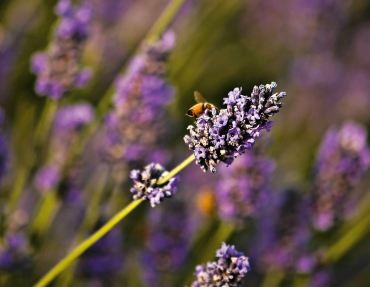
An old-fashioned, fragrant herb, lavender colors the garden with a purple haze in midsummer. This herb is so popular, it has its own festivals.
Lavender’s reputation is attributed to its beauty in the garden and diversity of use, from aromatherapy to crafting. The characteristics of lavender are legendary. Culinary, crafting and medicinal recipes have been passed down through history.
As modern technology and trends push many traditional herbal remedies aside, lavender’s uses remain tried and true today. It is truly an herb that has stood the test of time.
The botanical name “Lavandula” comes from the Latin “lavare,” meaning to wash. Lavender can be used as an antiseptic to wash wounds, a fragrant bathing herb and an insect repellant to fend off household pests.
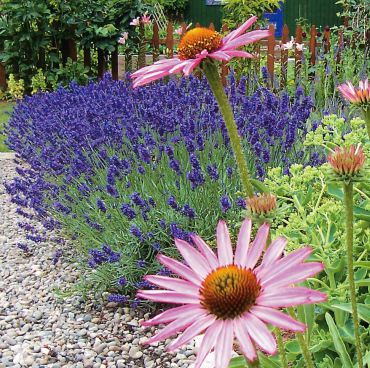 Linens washed in lavender-infused water linger a fresh, clean fragrance that naturally deodorizes. The aromatic essential oil is present in the whole plant, but is typically distilled from the flower buds.
Linens washed in lavender-infused water linger a fresh, clean fragrance that naturally deodorizes. The aromatic essential oil is present in the whole plant, but is typically distilled from the flower buds.
The oil’s medicinal qualities include a sedative and a skin cell renewal; it is relaxing, promotes sleep, and relieves stress and headaches. Queen Elizabeth I of England is said to have consumed up to 10 cups of lavender tea a day to relieve her migraines and Victorians used a tonic of lavender to prevent swooning and fainting spells.
For modern day use from the garden, grow lavender for household and skin remedies as well as cooking. The versatility of the herb also shows up in garden design for its uses as a border edging, hillside groundcover and an addition to mixed perennial borders.
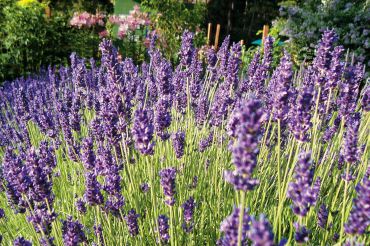 Growing Lavender
Growing Lavender
In North America, no lavender species is native but cultured varieties will thrive in a hot, sunny spot of the garden. It favors poor, rocky soil and is drought-tolerant.
Classified as a perennial, the plant has many varieties available, with growth habits from 10 inches to over 4 feet tall. Foliage colors range from deep greens to intense silver, with flowers rich-purple to light-lavender in color.
There are about 20 species of lavandula, with numerous named varieties in each. Some of the more familiar include: angustifolia, intermedia, multifidia, stoechas, lanata.
Most are quickly identified by their bracts or flower heads. To narrow the field of choices for your own garden, look for these species that have the best variety choices for the Pacific Northwest:
- English: L. angustifolias are some of the most common to find and have some of the hardiest varieties. They are highly aromatic and have the best range of flower colors.
- Spanish: L. stoechas can be tender in some climates. There is little fragrance and no medicinal value but the flower bracts are large and showy with color, making it one of the better ones for landscape use.
- X. Lavandins: a hybrid cross of angustifolia and latifolia. Latifolias are the best in high oil production, but the quality isn’t the same as the angustifolias, so the cross of parentage bears large flowers and long stems.
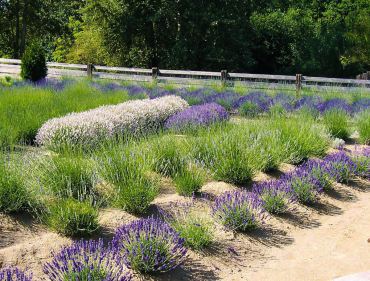 These are the best varieties for crafting and fresh-cut flowers. They are not seed producers and must be grown from cuttings.
These are the best varieties for crafting and fresh-cut flowers. They are not seed producers and must be grown from cuttings.
What You Need to Know about Lavender
Local lavender grower Susan Harrington, owner of Labyrinth Hill Lavender, gives her expert tips for growing lavender, answering frequently asked questions:
1. What kinds of pests and diseases attack lavender?
Most insects leave lavender alone. Spittlebugs are a nuisance, but do little damage and last only a few weeks. The many root-rot diseases that tend to plague lavender can easily be avoided if you’re careful to plant in well-drained soil and avoid overwatering.
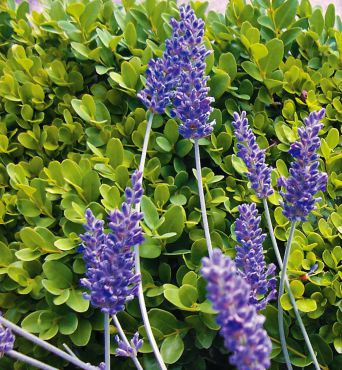 2. What is the best soil for growing lavender?
2. What is the best soil for growing lavender?
The best soil for growing lavender is a well-drained sandy loam with a pH factor between 6 and 8. Many of the hardier varieties will survive nutrient-poor soil and even flourish, but if their feet stay wet too long, as is common in slow-draining soils, they quickly die from root rot.
3. What is the best site for growing lavender?
The best site for growing lavender is on a slight to moderate slope with at least six hours of full sun. Partial morning shade will be OK but full afternoon sun is most important.
4. Will my lavender survive snow?
Lavender can and does survive snow better than prolonged severe freezing temperatures. Be sure the lavender has good drainage, and that it is a hardy species like some L. angustifolias and L. x intermedias.
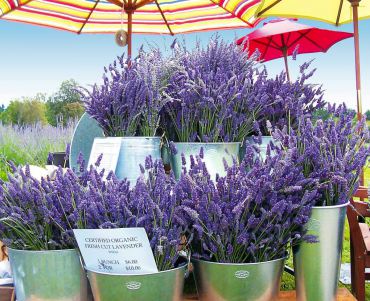 5. How often should I water my lavender?
5. How often should I water my lavender?
Avoid overhead watering. Though lavender is drought-tolerant, newly planted plants won’t survive drought until well established. Overwatering accounts for the demise of many more lavenders than underwatering. Do not plant your lavender near a lawn; it will receive too much water.
6. Should I fertilize it?
Apply dolomitic lime in the fall to raise the pH level if necessary. Apply bone meal or rock phosphate in the early spring after they’re a year old. That’s it! You don’t want to starve your lavender but overfertilizing could reduce the stem yields, oil content and delicate fragrance of the crop.
7. When should I prune my lavender?
The best time to prune is in the fall after you harvest. For the healthiest, most productive plants, annually prune back one-third to one-half of the previous year’s growth; do not cut any closer than two inches from the old wood.
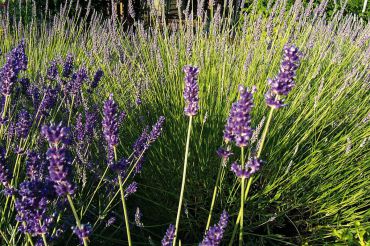 Harvesting and Forms of Use Flower Buds
Harvesting and Forms of Use Flower Buds
The English and Lavandin varieties are harvested just as the buds are in full of color, but not open.
Susan Harrington gives this advice: Harvest when 25 percent to 30 percent of the flowers have opened to achieve a balance of excellent color and fragrance. The buds are the most widely used part of the plant, containing the valuable qualities of the essential oils.
Harvest stems in the morning after the dew dries but before the hot sun releases the precious oils, and bundle with a rubber band. Hang to dry in a warm place with no sunlight and good air circulation.
When the buds are dry, they will easily shatter off the stems and can be stored in glass jars.
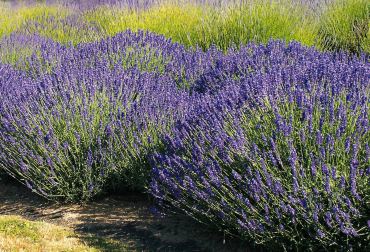 Stems: For crafting and bouquets, long-stem length in cutting is important. To harvest, cut as far down the stem as you can reach into the plant. Harvest in the morning after the dew dries but before the hot sun releases the fragrance.
Stems: For crafting and bouquets, long-stem length in cutting is important. To harvest, cut as far down the stem as you can reach into the plant. Harvest in the morning after the dew dries but before the hot sun releases the fragrance.
Disbudded dried stem bundles can be used in fireplaces on dying embers to smolder like incense.
Oils: Lavender essential oil quality is based on the variety of plant and the region it is grown in. By quantity and the distilling process, oil production is typically something a home gardener does not take on.
It takes approximately 50 pounds of lavender buds to produce 1 pound of essential oil; 1 acre of plants can produce 15 to 20 pounds of oil. Purchase oils from a reputable source or a local grower.





























